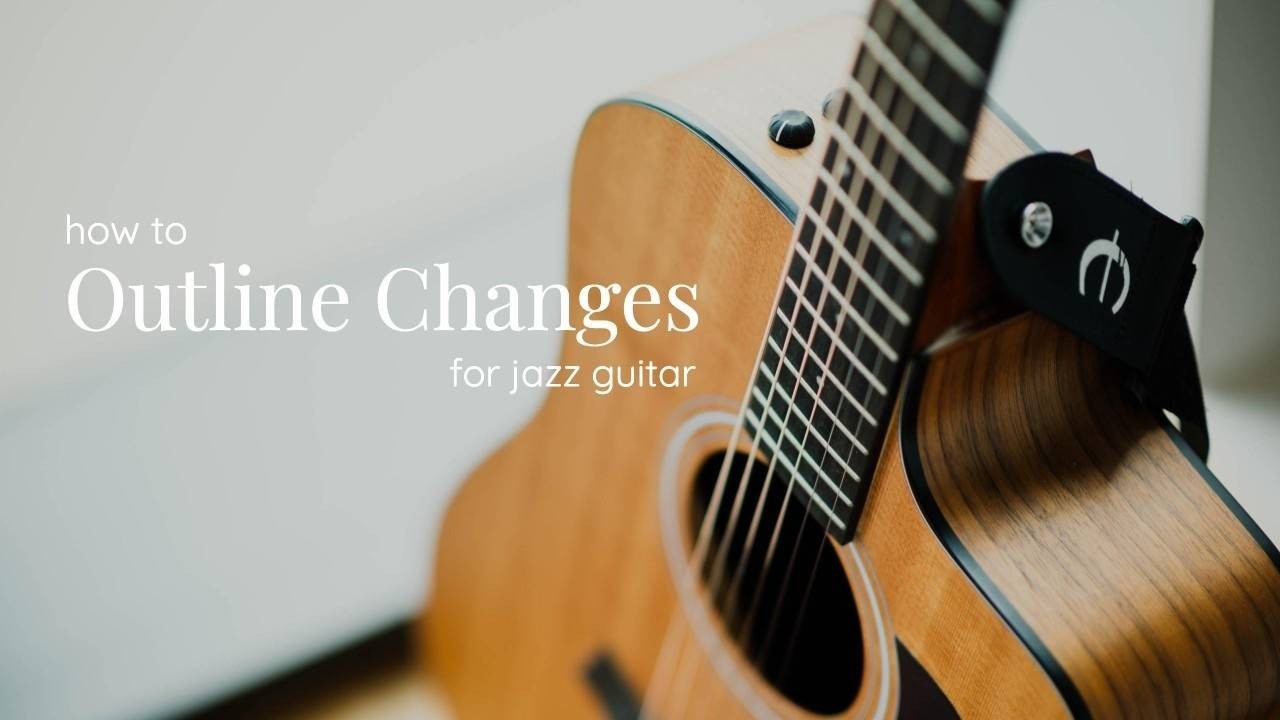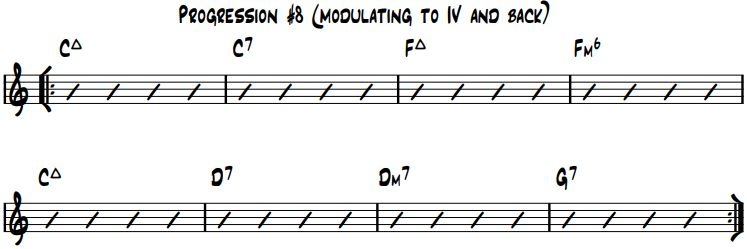
How to Outline the Changes for Jazz Guitar
Jan 11, 2021Learn to Play Over These Common Progressions (w/ Video + Audio)
You ever wonder how some improvisers can play lines without any accompaniment but still manage to make all of the changes stand out? Well, today we'll be going over how they approach it and what's in their "secret sauce."
Chord changes provide the backbone or framework for their improvisations. Today, we'll be going over 16 of the most common progressions. By learning to improvise effectively on these changes, you'll be well on your way to tackle most changes you'll find.
To make sure you get the most "bang for your buck," listen to and watch the audio and video clips we've provided.
The Goal of Improvisation
I find that the jazz chord progressions we are providing on this page present the perfect opportunity to learn how to outline chords while improvising.
The goal of an improviser is to freely create melodic content over a given harmonic framework. Therefore, it's easy to see why this is an important skill to develop! And if you want proof, go ahead and listen to guys like Jim Hall or Joe Pass. ;-)
Downloadable PDF Files
I have created some PDF files with all of the progressions we'll be discussing here. To give you an idea, I've provided several keys, but it's your job to do some of the dirty work and learn it in all 12!
Key of C | Key of Db | Key of Eb | Key of D | Key of E | Key of F | Key of Gb
How to Outline the Changes - Audio Intro
Be sure to listen carefully as there is some important information here. The last few minutes address questions by students.
Points to Take Away
Some of these points are taken from the audio, but I felt it important to reiterate in text.
- As with anything, make sure you start slowly - and I mean slowly. Take your time with this and make sure you are practicing correctly.
- The basic idea here is to outline the chords as clearly as possible in anything you practice. This will open up your options when you are confronted with a sight-reading situation and have to improvise over changes you've never seen.
- With regard to keys, my best advice would be to make sure you pick a different key each week. Start in C and go down the sheet. Switch keys every 7 days using the circle of 5ths. In other words, one week you will do C, then next week G, the following week D, and so on. The efforts you put in will show in all of the keys, so don't worry if you feel like you are wasting time!
- And finally, see Podcast #19 on our podcasts page. It features a discussion about this "Key of the Week" principle and how to integrate it into your own practice routine.
With that said, let's go ahead and get into the nitty gritty!
Jazz Progressions - Part 1: Fundamental Progressions
This video covers progressions 1-4. Let's go through and explain these individually.
Progression #1: I-vi-ii-V
- This is the infamous I-vi-ii-V progression and it's kind of the mother of all progressions in jazz music. Even outside of jazz, you've surely heard this progression tons of times. Most notably, any tunes based on the "rhythm changes" progression such as I've Got Rhythm, Oleo, Dexterity, and others.

Progression #2: Major Cycle
- The second progression can be found on a number of tunes such as Blues for Alice and There Will Never Be Another You. It's important to note that this one is sometimes altered to make the III chord a dominant chord.

Progression #3: Blues
- Perhaps the other most important progression in this music. Having a good understanding of the blues is absolutely crucial for any jazz player! Check out our blues information page for more info!

Progression #4: Minor Cycle
- This one is sometimes referred to as the "minor cycle" and can be found in none other than the tune Autumn Leaves. It might help to think of this one as a cadence in a major key followed by a cadence in a minor key. This particular progression is also found in different variations in a number of different tunes. Being able to handle this movement in fourths is crucial.

Jazz Progressions - Part 2: Common Variations On the Basics
This video covers progression 5-8.
Progression #5: Minor Blues
- This progression is much like #3 above, only this one is a minor blues. Note the difference in the harmony and how the target chords are approached. It might be a good idea to check out our lesson on playing over minor ii-V progressions. There are also tons of tunes written in this format. A good one to start out with is Mr. PC.

Progression #6-7: I-vi-ii-V w/ Alterations
- These two are just about identical to progression #1 in this lesson. The only difference is that these are making use of some secondary dominants. Basically, we're making use of secondary dominants here. All of the functions are the same with a little bit of added flavor.


Progression #8: Modulating to IV and Back
- Here we have a progression that starts on I, then briefly modulates to the IV chord before returning back to the I. You can find a bit of a variation of this on tunes like There Will Never Be Another You and Cherokee. In particular, this IV to IVm progression is technically a borrowed chord from the parallel minor key. It shows up quite a bit, so check out our major to minor lesson for some ideas on how to handle this.

Jazz Progressions - Part 3: Back-Cycling and Tritone Subs
This video covers progressions 9-11.
Progression #9: Back-Cycling from #IV
- In this progression, we're back-cycling from the #IV chord. You can find a variation of this idea in the tune Stella by Starlight. I personally really like the changes for the tune Like Someone In Love as a good example of this sort of idea.

Progression #10: Tritone Subs
- Here, we're making use of the infamous tritone subs. Pretty simple concept, really. Instead of going V7 to I, we're replacing the V7 with a bII7. Essentially, this substitution works because the 3rds and 7ths of the chords are the same but they're swapped.

Progression #11: Tritone Subs w/ I-vi-ii-V
- Similarly, we're using tritone subs here too but with a I-vi-ii-V progression. We're taking the same concept from the previous progression and applying it to the classic I-vi-ii-V progression.

Jazz Progressions - Part 4: Modal Interchange & Diminished Transitions
This video covers progression 12-14.
Progression #12: Modal Interchange
- This one contains a good bit of information. The first four bars contain a "backdoor cadence" of I-IVm7-bVII. The last four are a basic bebop turnaround of I-bIII-bVI-bII. This is often referred to as the Tadd Dameron changes.
Backdoor progression - Yardbird Suite, Lady Bird, My Romance
Tadd Dameron changes - Lady Bird, Half-Nelson

Progression #13: Diminished Passing Chords
- You can find this sort of passing diminished progression in a tune like It Could Happen to You or Have You Met Miss Jones?

Progression #14: Diminished Reharmonization
- This one is much like the previous one, only here, we are replacing the diminished passing chords with a ii-V to our next chord. It's essentially the same thing. Both are dominant functions.

Jazz Progressions - Part 5: Chromatic Basslines and Solar Changes
Progression #15: Chromatic Basslines
- For this progression, we have another back-cycling type of situation. It's important to be able to handle this type of progression as there are a great many tunes written this way. Some good examples of variations on this are There Will Never Be Another You and Like Someone In Love.

Progression #16: Solar
- And last but not least, we have the progression for the Miles Davis tune, Solar. This is a great jam session tune so make sure you know it!

Now You Try
I wouldn't be so bold as to say that this is everything you need, but if you are able to handle all of these progressions, you can definitely handle any of the old Great American Songbook tunes!
Lastly, remember to subscribe to our YouTube channel for more helpful tips and lessons. Share this with your friends and help us spread the word!
Please comment below with your questions, or if you'd like to share your favorite jazz guitar licks. See you soon!
**Notes from the Editor**This post was updated 11/01/2021. (New feature image and updated layout and syntax)









